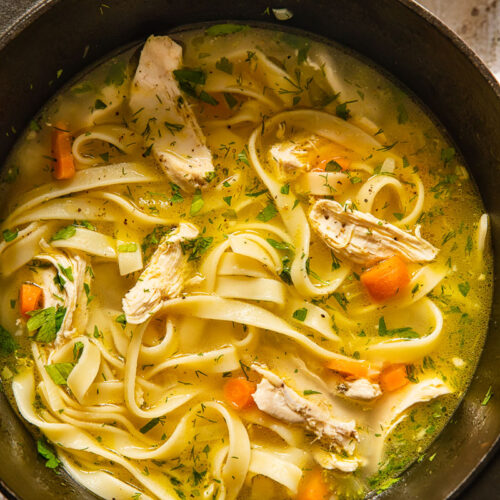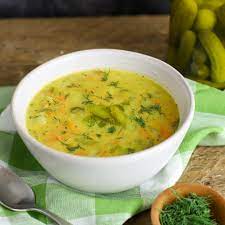When winter rolls around, there’s nothing quite as comforting as a warm bowl of homemade chicken noodle soup. But let’s face it – making soup from scratch can sometimes feel like a time-consuming process, especially when it involves cooking a whole chicken. The great news is, you can achieve that rich, hearty flavor without the extra work by using boneless, skinless chicken thighs. This method not only saves you time but also ensures a juicy and tender result.
This recipe provides a simplified approach, allowing you to enjoy a delicious, soul-soothing soup in just about 40 minutes. With minimal prep time and a few basic ingredients, you’ll have a satisfying meal that the whole family will love. Let’s dive into the details of making this easy chicken noodle soup.
Ingredients for the Perfect Chicken Noodle Soup
The beauty of this recipe lies in its simplicity and versatility. You don’t need fancy ingredients to make a flavorful soup – just the basics. Below are the ingredients you will need to create this delicious homemade dish:
- 2 tablespoons of butter, chicken fat, or olive oil: Each option brings its unique flavor. Butter provides a rich, comforting taste, chicken fat gives an extra layer of savory depth, and olive oil offers a lighter, healthier alternative.
- 1 large onion, finely chopped: Onion is the base of many soups and adds both flavor and sweetness when sautéed.
- 2 large carrots, peeled and chopped: Carrots provide sweetness and color, making your soup not only tasty but also visually appealing.
- 2 stalks of celery, chopped (optional): Celery adds a lovely crunch and a mild, savory flavor, but if you prefer, you can leave it out.
- 1 heaping tablespoon of minced garlic: Garlic enhances the aromatic base of the soup and gives it a savory kick.
- 2 bay leaves: Bay leaves are the secret to creating a complex flavor profile. They are a must-have for any well-made broth.
- 3 sprigs of fresh thyme or 1/2 teaspoon dried thyme: Thyme is another aromatic herb that pairs wonderfully with chicken, offering an earthy fragrance.
- 1 pound of skinless, boneless chicken thighs: Chicken thighs are perfect for this soup because they remain juicy and tender, even after simmering. You can use other cuts, but thighs really shine in this recipe.
- 8 cups of chicken stock or broth (low sodium or homemade): The stock is the foundation of your soup’s flavor. If you have homemade stock, use it! If not, store-bought low-sodium chicken broth works well too.
- 5 ounces of egg noodles (or pasta of your choice): Egg noodles are the classic choice, but feel free to swap them for any pasta shape you enjoy, like ditalini or rotini.
- Salt and pepper to taste: These two seasonings are essential for bringing out the flavors of the soup and balancing the broth.
- 1/4 cup of fresh parsley, finely chopped: Parsley adds a burst of freshness at the end and makes the soup look even more inviting.
- Water or additional stock (as needed): You may need extra liquid to adjust the soup’s consistency depending on your desired texture.
Preparing the Soup – Step-by-Step Instructions
Step 1: Sauté the Vegetables
The first step in creating a rich and flavorful base for your soup is sautéing the vegetables. Begin by melting the butter, chicken fat, or olive oil in a large pot or Dutch oven over medium heat. Once melted, add the chopped onion, carrots, and celery. Stir the vegetables occasionally, cooking them for about 5 to 6 minutes until they soften slightly. This gentle cooking process enhances the natural sweetness of the veggies, setting a solid foundation for the rest of the soup.
Step 2: Add Aromatics to the Mix
Now it’s time to introduce some fragrant herbs. Add the minced garlic, bay leaves, and thyme to the pot with the softened vegetables. Stir frequently to release the oils from the garlic and herbs, cooking for about 1 minute. The kitchen will start to smell incredible as the garlic and thyme infuse the air with their savory aroma.
Step 3: Bring in the Stock and Simmer
Once the aromatics have been added, pour in the chicken stock or broth, stirring to combine everything. Increase the heat slightly to bring the mixture to a gentle simmer. As the broth heats up, take a moment to taste it. Add salt and pepper to taste, remembering that the saltiness of your stock will influence how much seasoning you’ll need to add.
Step 4: Cook the Chicken
Submerge the chicken thighs into the simmering broth, ensuring they’re fully covered by the liquid. Bring the soup back to a low simmer and partially cover the pot with a lid. Let it cook for about 20 minutes, stirring occasionally. During this time, the chicken will cook through and absorb all the aromatic flavors from the broth. If the liquid level drops too low, feel free to add a splash of water or extra stock.
Step 5: Prepare the Noodles
While the chicken is cooking, you can prepare the noodles. Once the chicken has finished cooking, remove it from the pot and set it aside on a plate to cool slightly. Stir the noodles into the broth, making sure to follow the package instructions for cooking time (usually about 6 to 10 minutes). The noodles will soak up the flavors of the soup, creating that hearty, satisfying texture we all love in chicken noodle soup.
Step 6: Shred the Chicken
While the noodles cook, shred the chicken into bite-sized strips or cube it into small pieces using two forks. Once the noodles are tender, return the shredded chicken to the pot. Give everything a good stir to combine.
Step 7: Final Adjustments and Serve
Taste the soup one final time, adjusting the seasoning with more salt and pepper if needed. Add the freshly chopped parsley for a touch of color and freshness. Your comforting chicken noodle soup is now ready to serve!
Tips and Variations to Enhance Your Soup
- Choosing Your Fat: If you want a richer, more savory flavor, opt for chicken fat. Alternatively, olive oil offers a lighter, healthier version of the soup.
- Thickening the Soup: If you prefer a thicker consistency, try mixing a teaspoon of cornstarch with water and adding it to the broth during the noodle cooking stage.
- Herb Alternatives: Fresh thyme gives the soup a lovely fragrance, but if you don’t have fresh, dried thyme works just as well. You can also experiment with oregano or basil for a unique flavor twist.
- Noodle Variety: While egg noodles are the traditional choice, you can use any type of pasta that you like. Consider small shapes like ditalini, or try gluten-free noodles if you need to cater to dietary restrictions.
- Flavor Boost: Add a splash of fresh lemon juice or a few drops of Worcestershire sauce to elevate the savory notes of your soup.
Storing and Reheating Your Soup
Refrigeration: Store leftover soup in an airtight container in the fridge for up to 3 days. Keep in mind that the noodles will absorb more broth over time. When reheating, you can add a bit more stock or water to restore the consistency.
Freezing: To freeze, remove the portion you plan to freeze before adding the noodles. You can freeze the broth, chicken, and vegetables in a freezer-safe container for up to 3 months. When ready to enjoy, simply reheat the soup and cook fresh noodles in the hot broth.
Common Questions About Chicken Noodle Soup
- Can I use chicken breast instead of thighs? Yes, chicken breast is a viable alternative, but chicken thighs are preferred because they stay tender and juicy. If you use breast, reduce the cooking time slightly to avoid dryness.
- What if I don’t have fresh parsley? If fresh parsley is unavailable, you can substitute it with dried parsley (about 1 tablespoon) or omit it entirely. Fresh dill or chives are great alternatives as well.
- Can I make this soup gluten-free? Absolutely! Use gluten-free noodles or rice instead of egg noodles. Make sure the chicken stock is also gluten-free to keep the entire dish safe for those with gluten sensitivities.
- Can I add extra vegetables? Yes, feel free to incorporate additional veggies like peas, zucchini, or spinach during the last 5 minutes of cooking to enhance the nutritional value of your soup.
- How can I make the soup creamier? For a creamier texture, add a splash of heavy cream or coconut milk after the noodles are cooked. This will give the soup a rich, velvety finish.






